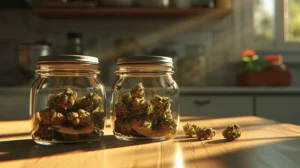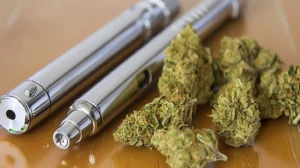Introduction to Seed Germination and Seedling Care
As an experienced cannabis cultivator, I know that the success of a grow starts with proper seed germination and seedling care. These crucial early stages lay the foundation for healthy and robust plants, which ultimately leads to bigger and better yields.
In this article, I will share my expertise on the best techniques for germinating seeds and caring for seedlings, as well as common mistakes to avoid and expert tips for success. So, let’s dive in!
What is Seed Germination?
Seed germination is the process of a dormant seed coming to life and developing into a seedling. This process can be tricky, especially for novice growers, but with the right knowledge and techniques, you can successfully germinate your seeds and produce healthy plants.
What are the Stages of Seed Germination?
Seed germination has three main stages: imbibition, germination, and seedling emergence. Imbibition is the initial absorption of water by the seed, and it triggers the start of the germination process. Germination is when the seed begins to sprout a root and develop its first leaves. Seedling emergence is when the seedling breaks through the surface of its growing medium.
How to Successfully Germinate Seeds?
Proper germination is crucial for the success of your grow. Here are some tips for successfully germinating your seeds:
- Use high-quality seeds from a reputable source.
- Choose a germination method that works best for you, such as paper towel method, direct planting, or using a germination kit.
- Keep the seeds in a warm and moist environment, around 70-85°F (21-29°C).
- Avoid overwatering, as it can cause the seeds to rot.
- Be patient and give your seeds time to germinate.
What are the Different Methods of Germinating Seeds?
The most common methods of germinating seeds are the paper towel method, direct planting, and using a germination kit. The paper towel method involves placing the seeds between damp paper towels and keeping them in a warm and dark place until they germinate. Direct planting is simply placing the seeds directly into the growing medium. A germination kit provides a controlled environment for the seeds to germinate in.
What are the Ideal Conditions for Germinating Seeds?
The ideal conditions for germinating seeds include:
- Warmth: Seeds need warmth to germinate, so keep them in a warm environment, around 70-85°F (21-29°C).
- Darkness: Light can interfere with the germination process, so keep the seeds in a dark place.
- Moisture: The growing medium should be damp, not soaked, to provide the right amount of moisture for the seeds to germinate.
- Airflow: Seeds need oxygen to germinate, so make sure there is enough airflow in the germination environment.
Caring for Cannabis Seedlings
Once your seeds have germinated and seedlings have emerged, it’s time to provide them with proper care for healthy growth. Here’s how:
- Keep the seedlings under a grow light for 18-24 hours a day.
- Use a growing medium that provides good drainage and aeration.
- Start using a diluted nutrient solution once the seedlings have developed their first few sets of leaves.
- Maintain proper humidity levels, around 60-70%, to prevent the seedlings from drying out.
What are the Essential Needs of Cannabis Seedlings?
Cannabis seedlings have specific needs to thrive, including:
- Proper lighting: Seedlings need 18-24 hours of light per day, and a full-spectrum grow light is ideal for their growth.
- Good growing medium: Choose a medium that provides good drainage and aeration, such as coco coir or peat moss.
- Nutrients: Seedlings need a small amount of nutrients to support their growth, but be careful not to overfeed them.
- Humidity: Maintaining proper humidity levels is crucial for the health of seedlings.
What is Seed Germination?
Seed germination is the process where a seed develops into a new plant. It starts with water absorption, leading to the seed swelling and germination. Factors like temperature, water, oxygen, and light influence germination. For instance, cannabis seeds require a warm, moist environment to germinate successfully.
Once the seedling emerges from the soil, proper care is essential to ensure healthy growth. A friend once struggled with seed germination until adjusting the watering schedule and providing consistent warmth. This simple change resulted in successful germination and thriving seedlings.
What are the Stages of Seed Germination?
The stages of seed germination are crucial for successful plant growth. The process begins with imbibition, where the seed absorbs water, causing it to swell. This leads to the seed coat rupturing, and the radicle, or embryonic root, emerging. Subsequently, the radicle elongates and develops root hairs. As the shoot emerges, it forms cotyledons, the first leaves of the seedling. These stages are vital for the seedling to establish itself and begin photosynthesis. Understanding what the stages of seed germination entail is essential for nurturing healthy plants.
How to Successfully Germinate Seeds
- Choose the right seeds: Ensure you acquire high-quality seeds from a reliable source for successful germination.
- Prepare the germination medium: Use a well-draining and sterile medium like peat pellets or seedling mix.
- Plant the seeds at the correct depth: Follow the recommended planting depth for each type of seed to promote successful germination.
- Provide adequate moisture: Keep the germination medium consistently moist but not waterlogged to support seed hydration and germination.
- Maintain optimal temperature and light: Place the seeds in a warm, well-lit area to facilitate the germination process.
- Monitor for germination signs: Regularly check for the emergence of the seedlings and provide gentle care during this delicate stage.
What are the Different Methods of Germinating Seeds?
When germinating seeds, various methods can be employed. Some common methods include:
- Using paper towels
- Soil
- Water
- A germination kit
Paper towel germination involves placing seeds between damp paper towels, while soil germination requires planting seeds in a suitable soil medium. Water germination entails soaking seeds in water until they sprout, and germination kits provide a controlled environment for seedling development. Each method has its advantages and is suitable for different types of seeds and personal preferences. Understanding what are the different methods of germinating seeds is crucial for successful seed germination and healthy seedling development.
What are the Ideal Conditions for Germinating Seeds?
The ideal conditions for germinating seeds include moisture, warmth, and oxygen. Ensure the planting medium is consistently moist but not waterlogged, typically achieved by lightly misting the seeds or using a humidity dome. Maintain a steady temperature, around 70-85°F, for most common plant seeds. Good air circulation is crucial to prevent mold and mildew, so using a fan on a low setting can help. Additionally, ensure the seeds have access to oxygen by not burying them too deeply in the planting medium.
Fun Fact: Did you know that some seeds require a period of cold, known as stratification, to break dormancy and germinate successfully?
Caring for Cannabis Seedlings
Lighting: Ensure that the seedlings receive sufficient light exposure, around 18 hours per day, using grow lights if natural sunlight is not adequate.
Temperature and Humidity: Maintain a temperature of 70-85°F and a humidity level of 50-70% for optimal growth.
Watering: Water the seedlings when the top inch of the soil feels dry, making sure there is proper drainage to avoid waterlogging.
Nutrients: Introduce nutrients gradually, starting with a balanced formula, then adjust based on the seedlings’ development.
Transplanting: When the seedlings have outgrown their initial containers, transplant them into larger pots to accommodate root growth.
In the 19th century, cannabis was widely used for medicinal purposes and was a common ingredient in various remedies. It wasn’t until the early 20th century that regulatory restrictions on cannabis began to emerge, leading to its classification as a controlled substance in most parts of the world.
What are the Essential Needs of Cannabis Seedlings?
Cannabis seedlings require specific conditions for optimal growth. They need ample light, preferably 18 hours a day, and a consistent temperature between 70-85°F. Adequate air circulation is crucial, and maintaining a humidity level of around 70% promotes healthy development. Seedlings also benefit from a gentle breeze, which encourages stem strength. Proper watering is essential; overwatering can lead to mold and root rot, while underwatering causes stress. It’s important to provide nutrients suited for the seedling stage, such as a balanced fertilizer with higher nitrogen content. Additionally, using a growing medium with good drainage and a pH level of 5.8-6.0 fosters robust root development. Understanding and meeting these essential needs are key to nurturing thriving cannabis seedlings.
How to Provide Optimal Lighting for Seedlings?
Choose the right light:
- Use fluorescent or LED grow lights with adjustable height to provide optimal lighting for seedlings.
Positioning:
- Hang the lights 2-3 inches above the seedlings, adjusting as they grow to maintain the optimal distance.
Duration:
- Ensure seedlings receive 14-16 hours of light per day to support healthy growth.
Consistency:
- Maintain a consistent lighting schedule to simulate natural daylight.
Monitor and adjust:
- Regularly check the seedlings for signs of light deficiency or excess, and adjust the lighting accordingly.
What are the Best Nutrients for Seedling Growth?
Choosing the best nutrients for seedling growth is crucial for healthy development. Seedlings require a balance of essential elements for optimal growth, including nitrogen, phosphorus, potassium, and micronutrients.
Opt for a balanced fertiliser with a higher ratio of phosphorus, such as 5-10-5, promoting strong root development. Additionally, consider organic options like compost tea or fish emulsion for a gentle nutrient supply.
When I started my garden, I researched the best nutrients for my seedlings. I opted for a balanced, organic fertiliser with a focus on phosphorus, and my seedlings flourished, showing robust growth and vibrant foliage.
Common Mistakes to Avoid in Seed Germination and Seedling Care
Overwatering: Avoid excessive watering to prevent the seeds from rotting or developing mould.
Planting Depth: Plant seeds at the correct depth to ensure proper germination and seedling growth.
Temperature Fluctuations: Maintain stable temperature conditions to support successful germination and early seedling development.
Poor Soil Quality: Use high-quality, well-draining soil to provide essential nutrients and prevent waterlogging.
Insufficient Light: Ensure adequate light exposure for healthy seedling growth, avoiding leggy or weak seedlings.
In 1942, the first cannabis seed bank, Dinafem Seeds, was established, pioneering the conservation and distribution of marijuana seeds for research and cultivation purposes.
What are the Most Common Mistakes in Seed Germination?
The most common mistakes in seed germination include:
- Overwatering, which can lead to rot and mould.
- Using old or poor-quality seeds, which may not germinate.
- Sowing seeds too deeply, which can hinder sprouting.
- Not providing adequate warmth, which can delay or inhibit germination.
- Failing to monitor for diseases and pests, which can lead to the destruction of seeds or seedlings.
It’s crucial to address these common mistakes to ensure successful seed germination. By avoiding these errors and following best practices, such as using high-quality seeds, maintaining appropriate moisture levels, and providing optimal warmth, you can significantly improve the chances of successful seed germination.
What are the Most Common Mistakes in Seedling Care?
The most common mistakes in seedling care include overwatering, which can lead to root rot and stunted growth. Additionally, using the wrong type or amount of fertiliser may cause nutrient burn or deficiencies. Inadequate lighting, either too much or too little, can hinder healthy seedling development. Poor ventilation and high humidity levels might result in fungal diseases or damping-off. Overhandling delicate seedlings can cause damage, affecting their growth. Lastly, planting seedlings too deep or too shallow in the growing medium can impact their ability to establish strong roots. Being mindful of these common mistakes and taking proactive measures can significantly improve the care and growth of seedlings.
Expert Tips for Successful Seed Germination and Seedling Care
Seed selection: Choose high-quality seeds and consider the strain’s growing conditions.
Germination method: Opt for paper towel or water germination for higher success rates.
Germination environment: Maintain a warm, dark, and moist environment, ensuring proper ventilation.
Planting seedlings: Gently transfer germinated seeds into a suitable growing medium at the right depth.
Light and water: Provide adequate light and water, avoiding overwatering and excessive light exposure.
Pro-tip: Ensure consistent environmental conditions and avoid disturbing the germination process to achieve successful seed germination and healthy seedling care.
What are Some Tips for Faster Germination?
To achieve faster germination, ensure the seeds are kept consistently moist through methods like misting or using a humidity dome. Pre-soaking seeds in water for 12-24 hours before planting can expedite the process. Maintaining a constant and optimal temperature, usually around 70-85°F, is crucial. Using a seedling heat mat can help regulate temperature. Additionally, employing a germination station with proper lighting, such as LED grow lights, can accelerate the germination process. Lastly, choosing the right potting mix with good aeration and drainage is essential for faster germination. By following these tips, you can significantly enhance the speed of seed germination for a successful start to your plants’ growth.
How to Identify and Fix Common Seedling Problems?
When identifying and addressing common seedling problems, follow these steps:
- Yellowing leaves: Check for overwatering, nutrient deficiencies, or pests. Adjust watering and consider fertilising based on the issue.
- Wilting or drooping: Evaluate moisture levels, as over or under-watering can cause this. Adjust watering frequency accordingly.
- Stunted growth: Assess light exposure and nutrient levels. Ensure adequate light and consider adjusting the nutrient solution.
- Leaf spots: Look for signs of disease, overwatering, or poor air circulation. Treat with appropriate fungicides or adjust watering practices.
- Weak stems: Provide stronger support or adjust environmental conditions to promote stronger growth.
Fact: Proper ventilation and air circulation are crucial in preventing common seedling problems like fungal diseases and mould growth.
.jpg)
Frequently Asked Questions
- What is the best method for germinating cannabis seeds at home?
- The most effective methods include the paper towel method, direct planting in soil, and using starter cubes. The paper towel method is simple and allows you to easily see germination, while direct soil planting avoids the need to transplant seedlings. Starter cubes are convenient but may require additional investment.
- How long does it typically take for cannabis seeds to germinate?
- Cannabis seeds usually germinate within 3 to 10 days. Factors like seed quality, temperature, and moisture can affect this timeline.
- What are the optimal conditions for cannabis seed germination?
- Maintain a consistent temperature of around 70-85°F (21-30°C) and high humidity levels. Minimal light is required until the seeds have fully germinated.
- How do I know if a cannabis seed is viable for germination?
- Viable seeds are generally darker in color, firm to the touch, and without cracks. Non-viable seeds often appear pale, feel soft, and are easily crushed.
- What are the first steps after my cannabis seeds have germinated?
- Once seeds sprout, they should be carefully transplanted to a growing medium if not already in one. Ensure gentle handling to avoid damaging the delicate roots and shoot.
- How often should I water cannabis seedlings?
- Water seedlings when the top inch of soil feels dry. Overwatering can be detrimental, so it’s crucial to ensure proper drainage and avoid waterlogged soil.
- What type of light is best for cannabis seedlings?
- Fluorescent or LED grow lights are ideal for seedlings, offering low intensity and minimal heat. Provide 14-18 hours of light per day.
- When should I start feeding nutrients to my cannabis seedlings?
- Begin with a mild nutrient solution about two weeks after germination or when the first true leaves appear. Use nutrients formulated specifically for seedlings.
- How can I protect my cannabis seedlings from common pests and diseases?
- Keep the growing area clean, monitor moisture levels to prevent mold, and use organic pest control methods as needed. Regularly inspect plants for signs of stress or infestation.
- When is the right time to transplant cannabis seedlings to a larger pot or outdoor environment?
- Transplant seedlings when they have developed 2-3 sets of true leaves and have outgrown their current container. When transplanting outdoors, ensure the risk of frost has passed and gradually acclimate seedlings to outdoor conditions.
Unlock the secrets of cannabis germination and seedling care with our exclusive newsletter! Tailored for home growers, each issue is packed with expert tips and tricks to ensure your seedlings thrive. From sprouting success to nurturing young plants, we cover it all. Subscribe now for invaluable insights and updates, and transform your cannabis cultivation journey. Don’t miss out on this essential resource for every aspiring cannabis gardener! 🌱✨






